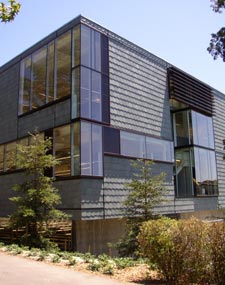Berkeleyan
Newly open: 28,775 sq. ft., lots of shelving, great views
Hargrove Music Library boasts prime location. This gem is in pristine condition; perfect for scholars!
![]()
| 18 August 2004
| |  The Hargrove Library’s design features elements selected both for aesthetic considerations and practical virtues (e.g., earthquake safety). (Christine Shaff photo) |
More space, the latest technology, climate controls, heightened security, and room for projected growth are among key features of the nearly $14-million Jean Hargrove Music Library, a new home for what has long been rated the No. 1 academic music library in the United States.
What one of its architects calls “a very efficient little building” not only enjoys a prominent location at the east end of North Field, but forms an “arts quadrangle” along with Wurster, Kroeber, Hertz, and Morrison halls. Its grateful denizens likely won’t think it all that little: The new library boasts 28,775 gross square feet, more than twice as much space as its predecessor on the second floor of Morrison Hall.
The three-story building houses 190,000 volumes of printed music, books, and periodicals, as well as more than 50,000 sound and video recordings and extensive collections of manuscripts and other rare materials — all well-protected by enhanced security and climate control. Among its treasures are the only known score of Alessandro Scarlatti’s 1683 opera, L’Aldimiro, as well as an 11th-century Gregorian chant manuscript, the papers of jazz great Earl “Fatha” Hines, and an original manuscript of Stravinsky’s ballet, Orpheus, written in his own hand.
The structure is named for Jean Gray Hargrove of Berkeley, a 1935 Music Department graduate and Bay Area concert pianist whose $4-million donation made its construction possible. Her portrait will hang in the reference room.
Designed by the award-winning firm of Mack Scogin Merrill Elam Architects of Atlanta, Ga., the new library features strategically placed amber-colored glass, green-slate exterior shingles, and natural light pouring through windows that afford spectacular views of the campus. “By judiciously placing windows and views, the library feels more open and expansive than you might expect from such a small building,” says architect Elam; the sense of space is enhanced by the library’s open structure of exposed pipes and struts.
University Librarian Tom Leonard, noting that in classical times music and athletics were often related, adds that it’s a “bonus” that the music library windows look out over the busy sports field just to the west, as well as the busy quad to the east and up toward the nearby hills. He commends the project for its architectural detail, landscaping, and the way the building “catches the sun nicely, giving the humanities a shining lamp of its own.”
An unusual feature of the new library is a first-floor layout corresponding to the city of Berkeley’s official street grid; in addition, the top two floors were rotated slightly to align with the historic grid of the campus. This “geometric phenomenon,” says Elam, lends a “certain generosity” to the perimeter of the top two floors, providing space for seating and study carrels.
Dark cherrywood study tables, carrels, and chairs were custom- designed by the Library Space Planning Office, says campus Library Architect Fred Yasaki. “The concept was to “warm” the industrial loft-like building with Craftsman-style wood furniture,” he says, adding that the custom furniture was designed to withstand heavy student use: “We wanted the furniture to not only look good, but to be very durable.”
The furniture matches the building’s interior cabinetry and finishes. Pieces were designed to meet patrons’ needs with task lighting, electrical outlets, and wireless data access.
A room on the first floor includes 46 computer stations, many linked to a digital music network. Listening and viewing equipment is available at each station, and there’s an electronic piano for reviewing keyboard music. “That’s something we haven’t had before, and it’s going to be very useful,” says Music Librarian John Roberts.
A seminar room for graduate teaching is equipped with a piano, sound and video equipment, and a projector and screen. Graduate students also can take advantage of a special study room.
Nearly 150 current periodicals are now publicly displayed, compared to less than half that number in the cramped quarters of the previous library, which went into service in 1958.
Getting along with the neighbors
Elam notes that designing the new library was “complex in terms of its neighbors,” specifying the “almost Brutalist/modern” style of Wurster, Kroeber, and Barrows Halls, the California style of Morrison and Hertz Halls, and the fanciful style of the Hearst Gymnasium.
“You have to make something that speaks to the place, but that doesn’t try to copy or reiterate anything that is already in the area,” she says. “The music library’s cubelike form lends a certain stability, allowing it to hold its own, and mediates among the surrounding buildings.”
The scalloped slate tiles on the library’s exterior were chosen to complement the surrounding buildings in terms of color, texture, and scale. They also serve another purpose: earthquake safety. The tiles, attached with copper nails, overlap one another but are not bound together by any physical device. That, Elam says, results in a building skin that can absorb more movement than many other designs. The building is also equipped with a system of unbounded braces for the same reason.
Completion of the music library project clears the way for the second phase of an expansion program for the Music Department. Eventually, the former library space in Morrison Hall will be renovated for faculty offices and additional teaching and rehearsal space.
A formal opening ceremony for the Hargrove Library is planned for Sunday, Sept. 26, coinciding with a scholarly symposium focused on manuscripts in the library’s collections.

